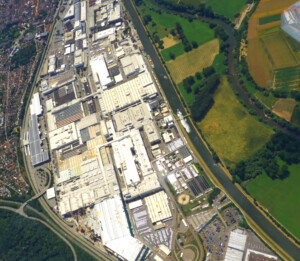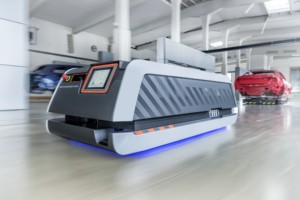
As part of my Grand Tour of German Automotive, I visited the two Audi plants in Germany, the headquarters in Ingolstadt and the second plant in Neckarsulm. In my last post I showed you Ingolstadt, in this post you will see Neckarsulm, which makes (among other things) the ultra-luxurious Audi A8 and its variants. Both plants are interesting, albeit for me the Neckarsulm plant performs and feels a bit better. Read on!
Disclaimer: The following is based on my personal observations and opinions and may not be accurate or correct. It is based on publicly available information and what I observed during public tours, and when I observed it. The observations may differ at a different time and place.
Audi Neckarsulm
Neckarsulm originates from the NSU motor bike plant, and the oldest building dates from 1910. It is less than half the size of Ingolstadt, having 15 500 employees making 1300 cars per day. Yet they claim that they have more variants than in Ingolstadt, making the A4, A5 Cabriolet, A6, A7, and A8 models on multiple lines. My visit was to the high-end A8 model line.

I got one bit of information on their employee creativity programs. They generate roughly 30 000 improvement ideas per year with 15 500 employees, or roughly two ideas per person per year. This is not bad. It is is twice of the number I heard from some other companies (roughly one idea per person per year), but far behind Toyota with roughly one idea per person per week. The workers worked in groups of 8–12 employees in two shifts.
A8 Final Assembly

The A8 is the high-end luxury model from Audi. These cars start at 100 000 EUR, but can be much more, especially for the stretch version that is 6.3 meter long. On this line they produce the A8 as a gasoline, diesel, and hybrid engine (the fully electric A8 e-tron version is planned for 2025). Most cars go to China, where they like black cars with lots of chrome. They also like fancy stuff like a foot heater and massage device.

As such, the demand is limited to the quite rich clientele, and the line was running at a slow takt of 12 minutes per car, which is much less than at other automotive lines for the poor plebs. On a previous visit the takt was at 9 minutes per car, but the speed is adjusted to the demand using flexible manpower. The lead time was 3 days, of which 1 day was actual working time. The line itself had 170 slots, or takte as it is often called in Germany.
As the takt is quite slow, there is a lot of work to remember for the workers (namely, 12 minutes of work), including many options and variations. Insofar it is surprising that this slow line can still hold up in terms of my estimate of the percentage of the time the worker adds value with 43%, which makes it the fastest final assembly line in the Volkswagen group after Porsche. Nevertheless, the line felt somewhat idle, and workers waiting and chatting was a frequent sight. In Ingolstadt, there was slightly less value-adding work, but it felt the employees had to do more preparation and other non-value-adding work, and had less time to idle. It also felt like there was a lot of space between employees, and the line seemed to use more space than what may have been needed. But that’s just my impression.
All cars are make to order, as there are too many options to build a car on stock. The sequence of production is finalized six days beforehand. For reference, Porsche Leipzig gives the sequence four hours beforehand to the supplier. A lot of material is delivered just in sequence (JIS).

Cars are transported on a moving platform and on C-hangers that can rotate for easy access to the underside of the car. AGVs were used to transport supplies to the line, but not the car itself. All items heavier than 5kg are moved using lifting devices to assist. Like most final assembly lines, most of the work is done by hand. The merger of the car body and the engine was almost fully automatic, with only two employees plugging in the cables. I also saw one robot that picked screws out of box, which is still not easy to do for robots and their limited camera vision. Like many other plants, robots also track if the screws were tightened correctly, and flag a problem if not. At the quality control at the end, red and green boxes indicate where there are problems.
Overall, an interesting plant. As always, many thanks to the companies that open their doors and permit visits to the general public. In my next post, I will go to the by far largest of all German automotive plants, the Volkswagen plant in Wolfsburg. Now, go out, build your fancy (and also less fancy) products efficiently, and organize your industry!
If You Want to Follow in My Footsteps

Audi offers tours in Germany both in Ingolstadt and in Neckarsulm. In Ingolstadt they have multiple options. The normal production tour takes 60 minutes with focus on assembly. Another tour with a 70 minutes duration focuses on the press shop and the body shop. A 2-hour intensive tour combines this and goes through the press shop, the body shop, and the final assembly. This is the tour I took. Many other tours are possible, including kids tours, school tours, family tours, and the option to include a dinner and/or a museum tour. These tours for Ingolstadt can be booked here. You need to lock away your mobile for these tours.
In Neckarsulm there are tours of the final assembly line, plus a workshop for kids. A logistics tour, a body shop tour, and an extended tour is only for groups. The tours can be booked here, including tickets for Neckarsulm. Both tours were well done, albeit I liked the extended tour in Ingolstadt more than the shorter one in Neckarsulm, simply because it gave me more time in the factory.
PS: Many thanks to Audi for offering tours through their plants to the public!
Discover more from AllAboutLean.com
Subscribe to get the latest posts sent to your email.
